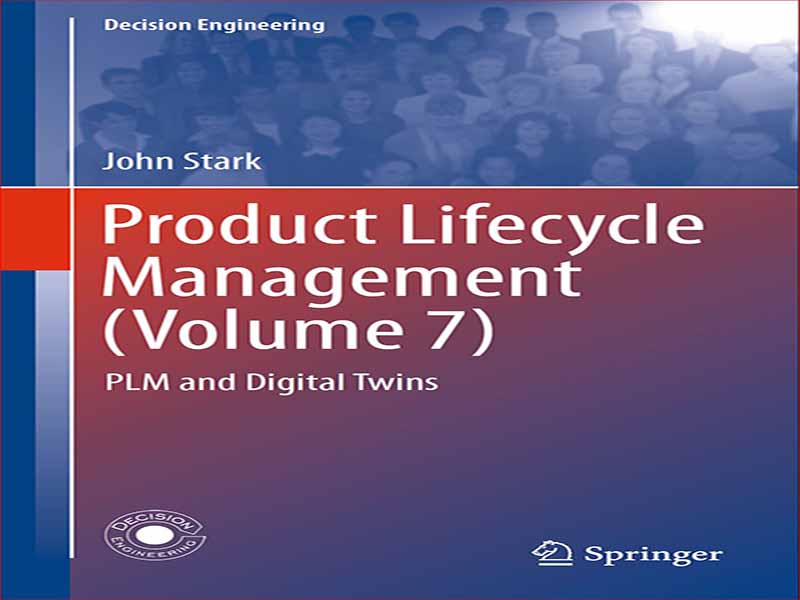- عنوان کتاب: Product Lifecycle Management (Volume 7)
- نویسنده/انتشارات: John Stark
- حوزه: مدیریت محصول
- سال انتشار: 2024
- تعداد صفحه: 188
- زبان اصلی: انگلیسی
- نوع فایل: pdf
- حجم فایل: 5.12 مگابایت
این هفتمین جلد از مجموعهای است که در سال 2003 با انتشار کتاب مدیریت چرخه عمر محصول: پارادایم قرن 21 برای تحقق محصول آغاز شد که به کتاب اصلی در PLM تبدیل شده است. بسیاری از جنبه های PLM در مجلدات قبلی این مجموعه مورد بررسی قرار گرفته است. این جلد به همگرایی سه فناوری میپردازد که در اوایل قرن بیست و یکم ظهور کردند: مدیریت چرخه عمر محصول، اینترنت اشیا (IoT) و دوقلوهای دیجیتال. اینها فناوری های کلیدی هستند که در قرن بیست و یکم در دسترس همه شرکت های تولیدی و مهندسی هستند، زیرا محصولات آنها در چرخه عمر محصول می گذرد. چرخه حیات با ایدهپردازی شروع میشود، تا تعریف، تحقق و استفاده/حمایت ادامه مییابد و با بازنشستگی/مصرف پایان مییابد.
PLM فعالیت تجاری برای مدیریت، به مؤثرترین روش، محصولات یک شرکت در تمام طول چرخه عمر آنها است. از اولین ایده برای یک محصول تا پایان بازنشستگی و کنار گذاشته شدن آن. اینترنت اشیا مجموعه ای از فناوری ها و منابع از جمله اینترنت است که یک شبکه ارتباطی است. چیزهایی (مانند محصولات)؛ دستگاه های الکترونیکی مختلف مانند فرستنده ها و سنسورها. و داده های ارسال شده از طریق اینترنت. اینها با هم، نظارت، تجزیه و تحلیل و بهینه سازی محصولات را در زمان واقعی امکان پذیر می کنند. Digital Twin یک نمایش دیجیتالی از یک موجودیت واقعی (مانند یک محصول) است که می تواند در ایده پردازی، توسعه، تحقق، استفاده/پشتیبانی و بازنشستگی/دفع موجودیت مورد استفاده قرار گیرد.
فصل 1 این جلد به معرفی PLM می پردازد. پیشینه و اجزای آن را مشخص می کند و اهمیت و مزایای آن را برجسته می کند. فصل 2 به اینترنت اشیا می پردازد. این توسعه و اجزای IoT را توصیف می کند و اهمیت و مزایای آن را برجسته می کند. فصل 3 جزئیات منشأ و اجزای دوقلوهای دیجیتال را ارائه می دهد و ارزش و مزایای آنها را برجسته می کند.
چهار فصل زیر به همگرایی PLM، IoT و Digital Twins در مراحل خاصی از چرخه عمر محصول می پردازد. فصل 4 به کاربردهای Digital Twins در مراحل ایده پردازی و توسعه محصول در چرخه عمر محصول می پردازد. اینها شامل پشتیبانی تصمیم، تسریع تکرار طراحی، بهبود محصول تکرارشونده، توسعه محصول جدید، مستندسازی محصول و فرآیند، بهینه سازی محصول، ارتقاء محصول، شبیه سازی، آموزش و تایپ اولیه مجازی است. نمونه هایی از استفاده از دوقلوهای دیجیتال توسط شرکت های تولیدی و مهندسی در طول مراحل ایده پردازی و توسعه محصول چرخه عمر محصول ارائه شده است.
فصل 5 استفاده از دوقلوهای دیجیتال را در فعالیت های بازاریابی و فروش در طول چرخه عمر محصول توضیح می دهد. آنها برای مثال در واقعیت افزوده (AR)/واقعیت مجازی (VR)، تحقیقات بازار، محتوای فروش شخصی، تجزیه و تحلیل پیشبینیکننده، سفارشیسازی محصول، مستندات محصول، تجسم محصول، فروش از راه دور، آموزش، محصول مجازی استفاده میشوند. تظاهرات و نمایشگاه های مجازی چندین مثال از شرکتهای تولیدی ارائه شده است که از دوقلوهای دیجیتال در بازاریابی و فروش در طول چرخه عمر محصول استفاده میکنند.
فصل 6 نحوه استفاده از Digital Twins در مرحله تحقق محصول چرخه عمر محصول را بررسی می کند. این بررسی شامل استفاده از آنها در AR/VR، نظارت و نگهداری تجهیزات، شبیهسازی فرآیند تولید، مستندات محصول، تضمین کیفیت و کنترل، همکاری زنجیره تامین، آموزش و نمونهسازی مجازی است. چند نمونه از شرکت های تولیدی که از Digital Twins در مرحله تحقق محصول استفاده می کنند، توضیح داده شده است.
فصل 7 به بررسی استفاده از دوقلوهای دیجیتال در مراحل پشتیبانی و دفع محصول در چرخه عمر محصول می پردازد. برنامه های کاربردی در این مرحله شامل مدیریت شکایت، مدیریت انطباق، جداسازی، دفع، مدیریت اثرات زیست محیطی، تشخیص خطا، مدیریت دانش، بازیابی مواد، بهینه سازی عملکرد، پشتیبانی شخصی مشتری، نگهداری پیش بینی، مستندات محصول و فرآیند، مدیریت محصول، بازیافت، نوسازی، پشتیبانی نظارتی، بازسازی، کمک از راه دور، نظارت و کنترل از راه دور، عیب یابی از راه دور، بهینه سازی قطعات یدکی، پس گرفتن، آموزش، راه اندازی مجازی و مدیریت زباله. چندین نمونه از شرکت های تولیدی که از دوقلوهای دیجیتال در مراحل پشتیبانی و دفع محصول استفاده می کنند ارائه شده است.
در نهایت، فصل. 8 فعالیت اجرای یک محیط PLM و Digital Twin یکپارچه در صنعت تولید را شرح می دهد.
ویژگی خاص کتاب این است که به سه فناوری قرن بیست و یکم می پردازد که برای همه شرکت های تولیدی کاربرد دارد. رویکرد اتخاذ شده صرفاً نظری نیست، بلکه به کاربرد عملی این فناوری ها در صنعت نیز می پردازد.
This is the 7th volume in a series that started in 2003 with the publication of Product Lifecycle Management: 21st Century Paradigm for Product Realisation, which has become the seminal book on PLM. Many aspects of PLM have been addressed in previous volumes in the series. This volume addresses the convergence of three tech-nologies that emerged in the early twenty-first century: Product Lifecycle Manage-ment, the Internet of Things (IoT), and Digital Twins. These are key technologies that are available to all manufacturing and engineering companies in the twenty-first century as their products go through the product lifecycle. The lifecycle starts with Ideation, continues through Definition, Realisation and Use/Support, and ends with Retirement/Disposal.
PLM is the business activity of managing, in the most effective way, a company’s products all the way across their lifecycles; from the very first idea for a product all the way through until it is retired and disposed of. The IoT is a collection of technologies and resources including the Internet, which is a communications network; Things (such as products); various electronic devices, such as transmitters and sensors; and data transmitted over the Internet. Together, these enable real-time monitoring, analysis, and optimisation of products. A Digital Twin is a digital representation of a real-world entity (such as a product) that can be used in the ideation, development, realisation, use/support, and retirement/disposal of the entity.
Chapter 1 of this volume introduces PLM. It outlines its background and compo-nents and highlights its importance and benefits. Chapter 2 addresses the IoT. It describes the IoT’s development and components and highlights its importance and the advantages it offers. Chapter 3 gives details of the origins and components of Digital Twins and highlights their value and benefits.
The following four chapters address the convergence of PLM, the IoT, and Digital Twins in specific phases of the product lifecycle. Chapter 4 looks at applications of Digital Twins in the Product Ideation and Development phases of the product lifecycle. These include decision support, design iteration acceleration, iterative product improvement, new product development, product and process documenta-tion, product optimisation, product upgrades, simulation, training, and virtual proto-typing. Examples are given of use of Digital Twins by manufacturing and engineering companies during the Product Ideation and Development phases of the product lifecycle.
Chapter 5 describes the use of Digital Twins in Marketing and Sales activities across the product lifecycle. They are used, for example, in Augmented Reality (AR)/Virtual Reality (VR), market research, personalised sales content, predic-tive analytics, product customisation, product documentation, product visualisa-tion, remote sales, training, virtual product demonstrations, and virtual showrooms. Several examples are presented of manufacturing companies using Digital Twins in Marketing and Sales during the product lifecycle.
Chapter 6 reviews how Digital Twins are used in the Product Realisation phase of the product lifecycle. The review includes their use in AR/VR, equipment monitoring and maintenance, manufacturing process simulation, product documentation, quality assurance and control, supply chain collaboration, training and virtual prototyping. Some examples of manufacturing companies using Digital Twins in the Product Realisation phase are described.
Chapter 7 explores the use of Digital Twins in the Product Support and Disposal phases of the product lifecycle. Applications in this phase include complaint management, compliance management, disassembly, disposal, environmental impact management, fault diagnosis, knowledge management, material recovery, perfor-mance optimisation, personalised customer support, predictive maintenance, product and process documentation, product management, recycling, refurbishing, regulatory support, remanufacturing, remote assistance, remote monitoring and control, remote troubleshooting, spare parts optimisation, take back, training, virtual commissioning, and waste management. Several examples of manufacturing companies using Digital Twins during the Product Support and Disposal phases are provided.
Finally, Chap. 8 describes the activity of implementing an integrated PLM and Digital Twin environment in manufacturing industry.
A special feature of the book is that it addresses three twenty-first century tech-nologies that apply to all manufacturing companies. The approach taken is not purely theoretical, but also addresses the practical application of these technologies in industry.
این کتاب را میتوانید از لینک زیر بصورت رایگان دانلود کنید:
Download: Product Lifecycle Management (Volume 7)



































نظرات کاربران